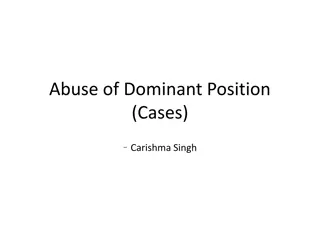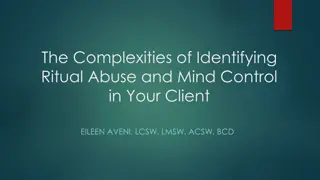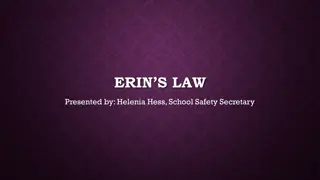ABUSE OF DOMINANT POSITION
Carishma Singh explains how abuse of dominant position (Section 4) is defined under the Competition Act, emphasizing that dominance alone is not anti-competitive, but coupled with abusive conduct, it can harm competitors, consumers, and markets. The law applies to both private and government entities, regardless of profit motives. The process of identifying abuse involves market assessment, dominance evaluation, and detecting abusive practices. Examples like Google's search bias highlight the consequences of abusing dominance.
Download Presentation

Please find below an Image/Link to download the presentation.
The content on the website is provided AS IS for your information and personal use only. It may not be sold, licensed, or shared on other websites without obtaining consent from the author. Download presentation by click this link. If you encounter any issues during the download, it is possible that the publisher has removed the file from their server.
E N D
Presentation Transcript
ABUSE OF DOMINANT POSITION (SECTION 4) - Carishma Singh
DOMINANCE + ABUSE 2 words- dominance+ abuse used under s.4 Dominance per se is not anti competitive Dominance coupled with abusive conduct is anti competitive under the Competition Act. S.4(1) : No enterprise or group (s.5(b) explanation : group of enterprises- added via amendment of 2007) shall abuse its dominant position
Does the section relate to private enterprises only? No, according to s. 2(h) the act is ownership neutral and equally applicable to private as well as government bodies acting in their commercial capacities. This simply means that CCI can probe anti competitive conduct or abuse on their part. This does not mean that it gives them authority to frame policies of government.
PROFIT MOTIVE profit motive is not a sine qua non for qualification as an enterprise that is engaged in abuse of its dominant position. markets that do not reflect the traditional buyer- consumer relationship have also been penalized in the past by CCI Google has been accused for abuse of dominant position in EU, India and Russia at different points of time. Its contention that its service of search was free and hence it was not covered by s.4 was not accepted by CCI which stated that its generation of revenue was through advertising. It was consequently fined heavily for search bias , and abuse of dominant position.
STEPS TO IDENTIFY ABUSE OF DP Identifying relevant product market and relevant geographical market Assessment of the dominance of the enterprise/ group in question Determining whether the dominant enterprise has pursued any activity that is abusive in nature i.e identifying if the enterprise used its dominance to abuse the market or its competitors or its consumers What is my market Am I dominant? Am I abusive?
s. 4(2) S.4(2) Explanation defines dominant position as a position of strength, enjoyed by an enterprise, in the relevant market, in India which enables it to- OPERATE INDEPENDENTLY of competitive forces prevailing in the relevant market (IRCTC) AFFECT ITS COMPETITORS or consumers or the relevant market in its favor (Air India few years ago-shares able to affect the market)
ABUSIVE CONDUCT Abusive conduct may be viewed as using the position of dominance to affect the competitor s business or the consumer s freedom of choice or the flow of market forces while also making sure that your position of dominance is unaffected.
RELEVANT MARKETS s. 2(r) May be determined by the Commission A relevant market is of 2 types- Relevant Product Market Relevant Geographical market
RELEVANT PRODUCT MARKET s. 2(t) Means a market comprising all those products or services which are regarded as INTERCHANGEABLE or SUBSTITUTABLE by the consumer, by reason of characteristics of the products or services, their prices and intended use A company may be manufacturing multiple products or offering multiple services. These need to be separated to check for interchangeability and substitution. Eg- Dove soap, and Bru coffee (Hindustan Unilever)
SSNIP Test/ Hypothetical Monopolistic Test SSNIP- Small but significant and non-transitory increase in price The test consists of observing whether a small increase in price (in the range of 5 - 10%) would provoke a significant number of consumers to switch to another product (in fact, substitute product). If the answer is yes- the products are of the same market i.e they belong to a relevant product market.
example An example of a relevant product market would include Ola and Uber. (Meru Travels Solutions Pvt Ltd v CCI) According to the definition of s.2(t), if Ola increases prices, a significant number of consumers shift to Uber wherever both are available.
RELEVANT GEOGRAPHICAL MARKET s. 2(s) Means a market comprising the area in which the conditions of competition for supply of goods or provision of services or demand of goods or services are distinctly homogeneous and can be distinguished from the conditions prevailing in the neighboring areas. This may be understood in terms of a boundary based on statehood, terrain, language, local requirements, consumer preferences etc.
example The question to be asked here is if the product is serviceable outside that territory and whether a consumer would go outside that boundary to purchase the same product/service? Example- horse milk (local requirements), bread (terrain), English to Malayalam books (language), coffee (consumer preferences) Maharashtra State Power Generation Limited v Coal India Limited and Ors delimited this to maximum of the entire territory of India and not beyond.- s.4(2)explanation (a)
S. 4(2) Abuse of DP if the enterprise (a) directly or indirectly, imposes unfair or discriminatory- (i) Condition :eg purchase bundled goods (ii) Price: eg excessive pricing or predatory pricing (amazon, uber) (b) Limits or restricts- (i) Production (to increase demand) (ii) Technical or scientific development (c) Indulges in practice or practices resulting in denial of market access; or (arbitrarily saying-I will sell my product to all but not you i.e exclusive dealing, tying: Hilti AG v Commission of the European Communities, Microsoft Corporation v. Commission) (d) Makes conclusion of contracts subject to acceptance by other parties which, by their nature or according to commercial usage, have no connection with the subject of such contracts (e) Uses its dominant position in one relevant market to enter into, or protect, other relevant market
s. 19(4) Factors considered by CCI to determine abuse of dominance- market share of the enterprise size and resources of the enterprise size and importance of the competitors economic power of the enterprise including commercial advantages over competitors vertical integration of the enterprises or sale or service network of such enterprises dependence of consumers on the enterprise
monopoly or dominant position whether acquired as a result of any statute or by virtue of being a Government company or a public sector undertaking or otherwise entry barriers including barriers such as regulatory barriers, financial risk, high capital cost of entry, marketing entry barriers, technical entry barriers, economies of scale, high cost of substitutable goods or service for consumers countervailing buying power market structure and size of market
social obligations and social costs relative advantage, by way of the contribution to the economic development, by the enterprise enjoying a dominant position having or likely to have appreciable adverse effect on competition any other factor which the Commission may consider relevant for the inquiry.
RAGHAVAN COMMITTEE REPORT Key questions for adjudication on abuse of dominance could include: How will the practice harm competition? Will it deter or prevent entry? Will it reduce incentives of the firm and its rivals to compete aggressively? Will it provide the dominant firm with an additional capacity to raise prices? Will it prevent investments in research and innovation? Do consumers benefit from lower prices and/or greater product and service availability?
Thus, in the context of abuse of dominance, the efficacy of the law hinges on the following questions: Do the provisions of the law make it too easy for a firm to be classified as dominant? Does the law protect potential entrants from exclusionary behavior by the incumbent firm(s)? Does the law seek to control the prices charged by dominant firms? Is there a suitable test for predatory pricing? Is there scope for applying the rule of reason to exclusionary vertical arrangements?
S. 27: Orders by CCI after inquiry Excel Crop Care case laid down a two-step approach to determine the size of the penalty, requiring that the penalty: should be based on the determination of the relevant turnover; and should be determined after considering the aggravating and mitigating circumstances rele- vant to each case.























